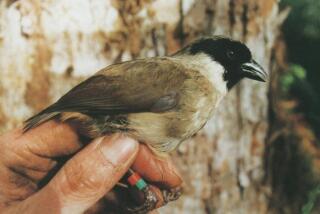Red List Finds 12.5% of Plant Species Face Extinction Threat
- Share via
WASHINGTON — At least one out of every eight plant species worldwide is threatened with extinction, scientists said Wednesday, urging action to protect “the building blocks” of our food and medicine.
The World Conservation Union’s Red List of Threatened Plants listed 33,798 species, or 12.5% of the 270,000 known species of vascular plants, as threatened. The list is the result of 20 years of work by botanists and conservationists worldwide.
“The message . . . should be distressing to all,” said Robert Fri, director of the Smithsonian Institution’s Museum of Natural History, at a news conference.
Scientists from organizations that helped compile the list described the results as “startling” and a clarion call to protect what one called “the bottom line of the food chain.”
“We all need to step up our commitment to action,” said David Brackett, chairman of the World Conservation Union’s species survival commission. In 1996, the group reported that 11% of all birds and 25% of mammal species were threatened.
Threatened plants included 32% of the lily and iris families; 75% of yew species, which have yielded cancer-fighting drugs; and 32% of dipterocarps, a tree family with Southeast Asian species prized for lumber.
“Plants are the building blocks of our food,” said Deborah Jensen of the Nature Conservancy. Brian Boom of the New York Botanical Garden added that one-fourth of medicines are drawn from plants.
Wild plants also constitute a gene pool for improving food and feed crops, Boom said, and thus have great economic potential.
Jensen, who cited a lily in the San Francisco area and a pea relative along the Potomac River south of Washington, said it is not uncommon for threatened species to live in urban areas.
For the Red List, scientists compared fern, conifer and flowering plant species around the world to historical listings. Vascular plants have specialized tissues that conduct water and food.
Loss of habitat through human activity, such as urbanization, and competition from nonnative plants and animals is the greatest problem for threatened plants. Jensen and others encouraged conservation through preserves, managed areas and botanical gardens as well as public education for private action.
More to Read
Sign up for Essential California
The most important California stories and recommendations in your inbox every morning.
You may occasionally receive promotional content from the Los Angeles Times.













